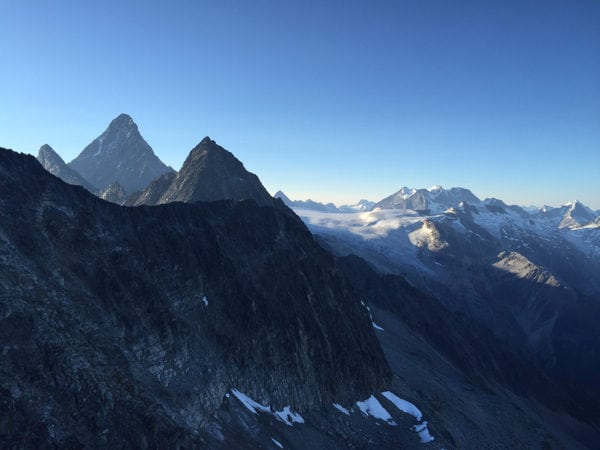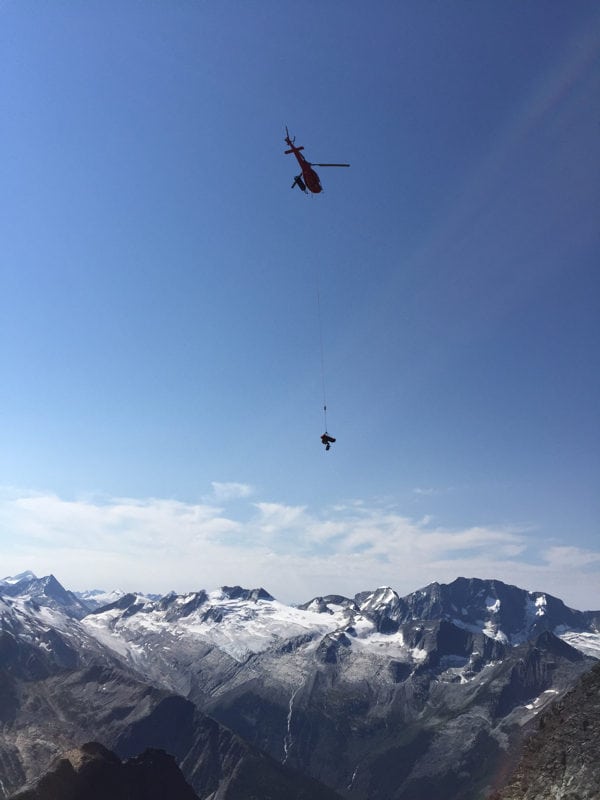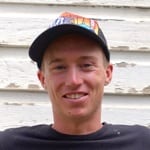 [Thanks to Salomon for supporting Dakota Jones’s column on iRunFar.]
[Thanks to Salomon for supporting Dakota Jones’s column on iRunFar.]
As far as climbing accidents go, Adam Campbell’s could have been a lot worse. Nick Elson and I were by his side within a minute of him coming to a stop on a steep slope of dirt and rocks, and we quickly ascertained that he was A) alive, B) conscious, C) had sensation in his legs, and D) hadn’t disfigured his face. I think those are the things that would have really freaked me out. As it was, he was still hurt badly and in terrible pain, but the rescuers came within an hour and a half, and by now he’s well on his way to recovery.
The rescuers arrived by way of a rope dangling from the bottom of a helicopter. Nick, Adam, and I, perched near the crest of a ridgeline looking south, were in command of a truly incredible view. Steep and jagged mountains; broad, dense glaciers; deep and forested mountains–the breathless wilderness of British Columbia. In the foreground of this tremendous geology flew the helicopter, small as a toy at first but quickly growing to life-size and with the roar to match. Soon it howled above us, wind thrust blowing every which way, and delicately landed two rescuers on nearby ground. They disconnected and signaled to the helicopter, which quickly vanished downvalley, leaving behind a heavy silence.
As they walked up to us, I couldn’t help but wonder, What are these guys thinking? Here was a group of search-and-rescue volunteers who had received a call about a bad fall in the mountains. With hardly any more knowledge than that they raced into their helicopter and sped up to us, prepared for… what exactly? How could they possibly prepare for what they didn’t know was happening? I was sitting with Adam, and I knew he wasn’t actively dying. But for all the S&R guys knew, he could have been bleeding out of an artery tear, or missing a leg, or any number of horrifying things. I could never do that job, I thought, shuddering. But thank goodness they do.
***
When I was in high school I volunteered at Hardrock, and the captain of the aid station where I worked was a teacher in Silverton. Like most Silverton locals, he had many jobs, and one of them was volunteering on the San Juan Search and Rescue team. While we sat in the glowing dusk waiting for the runners to arrive, he told us a grim story of a man who had been hit by a rock on the face of a mountain in the Weminuche Wilderness, and how the search had taken several days because of how his clothes blended into the rock. After days of helicopter recon and hiking loops, they had found this guy by simply climbing up the same route he took and finding him dead on a ledge. “Leo Lloyd found him,” he told us. “He’s the head of La Plata County Search and Rescue. He’s the man. The stuff he’s done… if you want to meet someone who knows what they’re doing, talk to Leo.”
That was all I needed to idolize Leo Lloyd, so it was with wide eyes and a sharp intake of breath that I learned a few weeks later that Leo was the father of one of my teammates on my cross-country team. Wanting to be a climber myself, I was nervous to meet a real climber like Leo, someone who had really done stuff. But when I finally introduced myself, he put my fears to rest. Leo is the friendliest person in whatever town he’s in. Before long he was taking Kendall (his son) and I climbing after school.
Leo spends a lot of time climbing with first-timers, giving them confidence to explore the vertical world. He also climbs with some consummate badasses. I had the opportunity to graduate through the Leo Lloyd school of climbing to somewhere in the middle. I’m no badass, but I have done stuff, and I think I can honestly say that I am a climber, though if only because I’ve realized you can slap whatever label you want on just about anything you do. I’ve had the opportunity to go on several climbing trips with Leo, and I’m proud to say that he has become a great mentor to me. I learned how to climb simply by climbing, but I learned how to climb safely and efficiently with Leo. Better yet, he set an example of climbing to enjoy yourself, rather than to try to be cool or set records. As a guy who has wanted to make a name for himself in the world of outdoor sports, this was an important lesson for me to learn. Many of my most enjoyable days of climbing have been with Leo, though we probably never climbed harder than 5.11. He climbs for fun, but he’s always teaching.
“Okay, Dakota,” he’ll say at the top of a pitch, “if I were to get hit by a rock while climbing up to you and was unconscious, how would you get us off the wall?”
I furrow my brow and look at our anchor, considering the situation. “Well,” I say, “I guess I’d want to get down to you first to see how you’re doing.”
“Okay,” he says. “How are you going to do that without me moving anymore? I’m already injured and you want me to stay put until you can see what the situation is like.”
Eventually I have to tell him I don’t know, and he then explains a simple but precise series of techniques that would allow me to secure him in place and then rappel down to get him. I listen closely and I understand what he’s telling me, but there are holes in what he’s saying. For example, once I get to him, how do we continue down off the wall? How do we go up the wall if that’s the only option? What if he gets hurt on a traversing section and I can’t simply rappel straight down to him? These questions have answers, and Leo knows these answers. But we’re climbing, not in class, and he keeps his descriptions short. “One of these days we’ll have to get you in a Rigging for Rescue class,” he says.
Leo is an instructor for Rigging for Rescue. Without going into too much detail, Rigging for Rescue is a company that gives classes to organizations like Yosemite Search and Rescue and Denali National Park’s climbing rangers on how to effect rescues in technical situations. To me, that seems like a hell of a pedigree. RFR is an authority on technical-rescue techniques in North America, and by climbing with Leo I have been able to pick up quite a lot of knowledge. But I never took a formal class.
Then Adam fell off a cliff, and I realized that I was woefully unprepared to deal with the kind of accidents that are very real possibilities in mountain running and climbing.
***
Another fortunate factor of Adam’s fall was that when he finally came to a stop, he was out of the technical zone. Since we were in ledge-y, class-4 terrain, we weren’t using ropes. It was the kind of area that is easy to move through quickly, but has consequences for mistakes. Adam pulled off a rock and it carried him head over heels completely off the rocks. Because of this, Nick and I did not have to effect a technical rescue, per se. That would mean we had to get Adam off of the technical terrain, but he was already in the scree field. So we were lucky in that regard. But I couldn’t help thinking about contingencies. What if he hadn’t stopped where he did? What if he needed us to get him off the rocks before the helicopter could pick him up? I realized that I had no idea how to do something like that, and it suddenly seemed like a nearly unforgivable oversight, like the absolute height of willful ignorance to attempt such a dangerous route without a back-up plan. This line of thinking quickly led me back to Leo Lloyd.
I don’t think I was scarred from Adam’s accident. Not like him certainly, and not very badly in an emotional way either. But that accident really drove home the seriousness of what a lot of us do on a regular basis, often without considering the possibilities. In that event I was given a very visceral demonstration of what can happen in the mountains. A single misstep, a tiny poor judgement, or simply bad luck, and all of a sudden you’re in a crumpled, bloody heap with the dust of rockfall settling around you. It’s very real, and it’s scary.
Yet a week later I went rock climbing. In fact, I spent more time climbing in September than I did all year before that. And I was fine, because most of the time climbers are. But the memory of what could happen stayed with me, and I triple-checked every knot and anchor before trusting them. I continued to think about contingency plans, and the need to bolster my knowledge grew to an unavoidable weight within me. There’s no point in being the best climber if you aren’t safe; and the fun comes to a screeching halt when someone gets hurt. To be truly responsible–to be able to look my friends and family in the eye when I tell them I’m careful in the mountains–I need to know how to get myself and my friends out of technical situations if someone gets hurt. So I signed up for a Rigging for Rescue course.
They aren’t cheap. I paid $1,100 for the privilege of spending five days learning to rig up different types of rescues. But you know what’s even more expensive? That’s right–a helicopter ride. Unfortunately, RFR doesn’t teach you how to avoid the helicopter ride; they teach you how to get your buddy off the wall so that he can get into the helicopter faster. If you get hurt in the mountains, there’s a really high likelihood that you’re going to incur some serious costs in getting carried out of there by the real professionals. But I cannot imagine anything worse than a feeling of helplessness in a scary situation. If I am rock climbing and my partner gets seriously hurt, I need to be able to safely and effectively give him the best immediate care possible before search and rescue arrives. That’s worth a lot more than money to me.
When the Canadian S&R guys landed on that Rogers Pass mountainside and walked up to us, they really didn’t know what they were going to find. But they have spent years training for situations exactly like that, going through countless simulations and later gaining experience in the real thing, in situations just like what we had called them up there for. Those experiences gave those guys the ability to walk up to us and control the situation. Because of them Adam will be okay. They didn’t do anything fancy, but they took control and solved the problem. Having taken a rescue course myself, I still don’t feel like I’m capable of that myself. But I have a better understanding of how they were. That’s a big step forward.
***
Outdoor athletes are now accomplishing things in the mountains that would have been unbelievable just a generation ago. They’re reaching a level of mainstream recognition, too, that allows them to make whole careers out of their sports, thereby giving them the time and resources to pull off visionary achievements. The strength of these people, and their ability to move through fantastical terrain, is gorgeous. Climbers, runners, skiers, and so many more people are able to engage for brief moments of their lives with a near-divine sense of purpose and the delicate strength of real power. But the margins of safety are slim; some would say that is why these athletes do what they do–to defy the risks–but that may not tell the whole story. There is something unique in “embrac[ing] the unknown, working with my fear in a world of indescribable beauty,” as Kelly Cordes puts it.
The risk is ever present, waxing and waning by the infinite varieties of terrain and weather and confidence. We can train and practice and prepare as much as possible, but bad things happen to good people. I’m not sure what level of risk is acceptable for me at this point, but I can say that a life of no risk is unacceptable. I just want to have fun in the mountains, and challenge myself, and create relationships. And it feels good to have a little more knowledge about how to stay safe. Then maybe I can do this longer.
Call for Comments (from Meghan)
- Do you engage in outdoor activities that carry significant risk? How do you manage and mitigate that risk? With classes? Self training? By refraining from certain activities when the risk level is too high for you? Some other way?
- Do you go into the outdoors with a back-up plan or ‘escape route?’ If so, can you share an example of how you do this?
- What level of risk you are comfortable with undertaking in your outdoor activities? Has it varied through your life, in different activities, or with your increasing experience levels?


